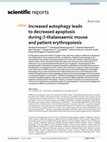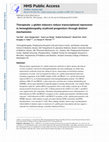Papers by Suthat Fucharoen
Acta Haematologica, 2009
semia alleles, UAE is arguably the most heterogeneous population in the world. The diversity of t... more semia alleles, UAE is arguably the most heterogeneous population in the world. The diversity of these mutations refl ects the historical admixture of genes and their migration from different areas in the region. Our data strongly suggest the need for a comprehensive thalassemia control program and provides a basis for population screening, genetic counseling and prenatal diagnosis.
Birth defects original article series, 1988
Description/Abstract This book contains papers divided among the following sections: molecular bi... more Description/Abstract This book contains papers divided among the following sections: molecular biology and pathogenesis; pathophysiology-molecular and cellular; clinical manifestations and hematologic changes; cardiopulmonary defects and platelet function; ...
PubMed, 1992
Data are reviewed describing hypoxemia, a newly identified feature in thalassemia. Evidence indic... more Data are reviewed describing hypoxemia, a newly identified feature in thalassemia. Evidence indicates platelet aggregation in the pulmonary circulation as being a key factor leading to hypoxemia and cor-pulmonale with right heart failure.
International Journal of Laboratory Hematology, Sep 14, 2011
International Journal of Laboratory Hematology, Oct 5, 2011
Although DNA analysis is needed for characterization of the mutations that cause b-thalassaemia, ... more Although DNA analysis is needed for characterization of the mutations that cause b-thalassaemia, measurement of the Hb A 2 is essential for the routine identification of people who are carriers of b-thalassaemia. The methods of quantitating Hb A 2 are described together with pitfalls in undertaking these laboratory tests with particular emphasis on automated high-performance liquid chromatography and capillary electrophoresis.

PubMed, Aug 1, 2013
Erythropoiesis, a process of erythroid production, is controlled by several factors including oxy... more Erythropoiesis, a process of erythroid production, is controlled by several factors including oxygen level. In this study, the effect of oxygen tension on erythropoiesis was investigated in K562 erythroleukemic cell line and erythroid progenitor cells derived from normal and β-thalassemia/hemoglobin (Hb) E individuals. The enhanced erythroid differentiation specific markers including increased levels of α-, β- and γ-globin gene expressions, numbers of HbF positive cells and the presence of glycophorin A surface marker were observed during cell culture under hypoxic atmosphere. The result also showed that miR-210, one of the hypoxia-induced miRNAs, was up-regulated in K562 and β-thalassemia/HbE progenitor cells cultured under hypoxic condition. Inhibition of miR-210 expression leads to reduction of the globin gene expression and delayed maturation in K562 and erythroid progenitor cells. This indicated that miR-210 contributes to hypoxia-induced erythroid differentiation in both K562 cells and β-thalassemia/HbE erythroid progenitor cells.
The New England Journal of Medicine, Jun 11, 1981
Case 1 was a 25-year-old man whose weight was 42 kg and height 158 cm. Studies of erythrocyte hem... more Case 1 was a 25-year-old man whose weight was 42 kg and height 158 cm. Studies of erythrocyte hemoglobin showed 57 per cent to be hemoglobin E, and the remainder hemoglobin F. His hemoglobin concentrations had previously fluctuated between 3.8 and 6.7 g per deciliter of whole ...

Scientific Reports, Nov 3, 2022
β-Thalassaemia results from defects in β-globin chain production, leading to ineffective erythrop... more β-Thalassaemia results from defects in β-globin chain production, leading to ineffective erythropoiesis and subsequently to severe anaemia and other complications. Apoptosis and autophagy are the main pathways that regulate the balance between cell survival and cell death in response to diverse cellular stresses. Herein, the death of erythroid lineage cells in the bone marrow from both β IVS2-654thalassaemic mice and β-thalassaemia/HbE patients was investigated. Phosphatidylserine (PS)bearing basophilic erythroblasts and polychromatophilic erythroblasts were significantly increased in β-thalassaemia as compared to controls. However, the activation of caspase 8, caspase 9 and caspase 3 was minimal and not different from control in both murine and human thalassaemic erythroblasts. Interestingly, bone marrow erythroblasts from both β-thalassaemic mice and β-thalassaemia/HbE patients had significantly increased autophagy as shown by increased autophagosomes and increased co-localization between LC3 and LAMP-1. Inhibition of autophagy by chloroquine caused significantly increased erythroblast apoptosis. We have demonstrated increased autophagy which led to minimal apoptosis in β-thalassaemic erythroblasts. However, increased PS exposure occurring through other mechanisms in thalassaemic erythroblasts might cause rapid phagocytic removal by macrophages and consequently ineffective erythropoiesis in β-thalassaemia. Abbreviation LC3 or MAP1LC3B Microtubule-associated protein 1A/1B light chain 3B Ineffective erythropoiesis causes severe anaemia in β-thalassaemia 1. Erythrokinetic and ferrokinetic analyses have shown clear evidence that the bone marrow is the main site of erythroid cell death, with as many as 65% of erythroid precursors dying in the marrow 2. Bone marrow from β-thalassaemia patients show marked erythroid hyperplasia, with an increased percentage of basophilic erythroblasts and polychromatophilic erythroblasts but with a decreased percentage of orthochromic erythroblasts 3-5. Increased phosphatidylserine (PS)-bearing erythroid cells in the bone marrow from β-thalassaemia patients has been reported 2,4. Accelerated apoptosis of β-thalassaemia erythroblasts has been demonstrated by increased PS exposure, DNA laddering and Hoechst 33342 positive staining in both ex vivo and in vitro culture systems of bone marrow erythroblasts from β-thalassaemia patients 2,4,5. Apoptosis at the polychromatophilic erythroblast stage was also demonstrated in cell culture of erythroid progenitor cells obtained from β-thalassaemia bone marrow through annexin V/propidium

Blood Cells Molecules and Diseases, 2016
Pharmacologic augmentation of γ-globin expression sufficient to reduce anemia and clinical severi... more Pharmacologic augmentation of γ-globin expression sufficient to reduce anemia and clinical severity in patients with diverse hemoglobinopathies has been challenging. In studies here, representative molecules from four chemical classes, representing several distinct primary mechanisms of action, were investigated for effects on γ-globin transcriptional repressors, including components of the NuRD complex (LSD1 and HDACs 2-3), and the downstream repressor BCL11A, in erythroid progenitors from hemoglobinopathy patients. Two HDAC inhibitors (MS-275 and SB939), a short-chain fatty acid derivative (sodium dimethylbutyrate [SDMB]), and an agent identified in high-throughput screening, Benserazide, were studied. These therapeutics induced γ globin mRNA in progenitors above same subject controls up to 20-fold, and increased F-reticulocytes up to 20%. Cellular protein levels of BCL11A, LSD-1, and KLF1 were suppressed by the compounds. Chromatin immunoprecipitation assays demonstrated a 3.6fold reduction in LSD1 and HDAC3 occupancy in the γ-globin gene promoter with Benserazide exposure, 3-fold reduction in LSD-1 and HDAC2 occupancy in the γ-globin gene promoter with SDMB exposure, while markers of gene activation (histone H3K9 acetylation and H3K4 demethylation), were enriched 5.7-fold. These findings identify clinical-stage oral therapeutics which inhibit or displace major co-repressors of γ-globin gene transcription and may suggest a rationale for combination therapy to produce enhanced efficacy.

Blood, Nov 16, 2004
β-Thalassemia/Hb E patients encompass a number of clinical severities, ranging from nearly asympt... more β-Thalassemia/Hb E patients encompass a number of clinical severities, ranging from nearly asymptomatic to transfusion-dependent thalassemia major. This has been well documented, but the causes of the variability and the molecular basis of the interaction remain unexplained. In general any factor capable of reducing the degree of alpha-globin-beta-globin chain imbalance will result in a milder form of thalassemia. The major modifying factors demonstrated in the mild cases are coinheritance of mild β+-thalassemia and Hb E genes, coinheritance of α-thalassemia and increased production of Hb F. However, the fact that many patients who have seemingly identical genotypes, β0-thalassemia/Hb E, and do not have a detectable α-thalassemia or increased Hb F production still have mild clinical symptoms, while other patients have a very severe clinical condition similar to homozygous β0-thalassemia. This variation suggests that other unknown modifying genetic factors may contribute to severity of the disease. To assess the relative contribution of genetic factors in the variation of severity among β-thalassemia/Hb E patients, we conducted a prospective study searching for modifying factors in almost 1100 Thai/Chinese β0-thalassemia/Hb E patients from Thailand using an automated, chip-based platform based on mass spectrometry (Sequenom’s MassARRAYTM system). A map of ~80 single nucleotide polymorphisms (SNPs) has been constructed spanning more than 80 kb, including the locus control region (LCR) and all beta-like globin genes. These SNPs were identified through resequencing and from the public domain, including well-characterized restriction fragment length polymorphisms (RFLPs) used in prior haplotype studies. Included in this panel are assays for polymorphic sites reported to influence globin gene expression, specifically Gγ-Xmn I polymorphism and BP-1 binding site upstream of β-globin gene. Genotyping of other candidate modifier loci, including SNPs in genes encoding alpha hemoglobin stabilizing protein (AHSP), β-globin gene repressor BP-1 protein, erythropoietin (Epo), and transcription factors; GATA-1, EKLF, NF-E2, has been studied. To identify additional modifier loci, carefully selected patient sub-groups representing the extremes in disease severity either mild or severe have been selected for DNA pool construction to be used in a genomewide screen involving up to 100,000 validated gene-based SNPs. It is expected that this genomewide screen will yield important information on the role of candidate genes and may uncover the association of novel polymorphisms with severity heterogeneity in β-thalassemia/Hb E disease.

Annals of Translational Medicine, May 9, 2015
Thalassemia is a hereditary disease affecting hemoglobin synthesis, characterized by microcytic h... more Thalassemia is a hereditary disease affecting hemoglobin synthesis, characterized by microcytic hypochromic anemia. Homozygote or compound heterozygote patients usually manifested as thalassemia major which require regular treatment. There are five functional genes arranged in the order 5' e-Gγ-Aγ-ψβ-δ-β 3' that are activated during development. Expression of the individual genes within the β-globin cluster is controlled by the complex interactions between local regulatory sequence (promoter regions) within each gene and the β-locus control region (β-LCR), located 6-18 kb upstream of the e-globin gene. Beta thalassemia (β-thal) is a very heterogeneous disorder due to variations in inactivation mechanism of the β-genes. Point mutations and small deletions or insertions in the nucleotide sequences are the main molecular defects responsible for most β-thalassemia. In spite of seemingly identical genotypes, severity of β-thal patients can vary greatly. This heterogeneity in the clinical severity may occur from the nature of β-globin gene mutation, α-thalassemia (α-thal) gene interaction and difference in the amount of Hb F production that is partly associated with a specific β-globin haplotype. Co-inheritance of α-thal may ameliorate the severity of β-thal disease in those cases with mild β-thal genotypes. However, many patients who are β°/β+ thal or β°-thal/Hb E do not have a detectable α-thal haplotype but still have a mild clinical symptom suggests that there are other additional factors responsible for the mildness of the disease. Inheritance of a β-thal chromosome with the Xmn I+ haplotype at the position -158 of the Gγ-globin gene was found to be associated with increased Hb F production and milder anemia in patients with thalassemia intermedia and Xmn I +/+ haplotype is necessary to produce a significant clinical effect. Homozygosity for the Xmn I + haplotype, +/+, was also found in the mild cases of β-thal/Hb E. However, there is no severity difference among homozygous β-thal patients with Xmn I +/+, −/+ or −/−. The GWAS study of the whole genome with more than 6000,000 SNPs of 1,100 β-thal/Hb E patients with mild and severe diseases revealed SNPs in three independent genes that show significant association with the disease severity. The strongest SNPs associated with the disease severity located in three regions; the β-globin gene cluster on chromosome 11, the HBS1L-MYB intergenic region on chromosome 6q23 and the BCL11A gene on chromosome 2p15. Further analysis of Hb F level showed that Hb F level was significantly higher in mild patients than moderate and severe patients (%Hb F; mild =42.6±11.5, moderate =35.7±11.1, severe =32.4±12.1; P<0.001). The association of Hb F level and frequency of Hb F-QTLs was studied in 520 cases. All individual SNPs on Hb F-QTLs are associated with Hb F (P value <10−5). Thirteen tagging SNPs were selected from three Hb F-QTLs. Of the common haplotypes CA haplotypes of BCL11A; CG haplotypes of HMIP; TTCTGTTAA and TTCTGTTAG haplotypes of β-globin gene cluster showed association with high HbF level. Our data indicated that several genetic loci act in concert to influence Hb F levels and disease severity of β-thal/HbE patients. Understanding the genetic modifier in β-thalassemia is important for the management of β-thalassemia patients from PND to prognosis and decision for difficult treatment such as stem cell transplantation. Moreover, this may lead to future alternative treatment of β-thalassemia patients as well.

วารสารเภสัชวิทยา (Thai Journal of Pharmacology), 2004
Cardiovascular disease is a common finding in thalassemia. Propranolol is a nonselective beta-adr... more Cardiovascular disease is a common finding in thalassemia. Propranolol is a nonselective beta-adrenergic blocking drug widely uses for the treatment of cardiovascular disease. Therefore this study was performed to investigate the pharmacokinetics of propranolol in β-thalassemia/hemoglobin E patients compare to normal volunteers. Each subject took a single 40 mg oral dose of propranolol. Blood samples were obtained for measurement of the plasma propranolol levels, using HPLC technique, blood pressure and heart rate were monitored before and at 0.5, 1, 1.5, 2, 2.5, 3, 4, 6 and 8 hours after drug administration. The pharmacokinetic parameters were determined. The peak plasma concentration (Cmax) of propranolol in the patients was not significant difference from normal. The time to reach peak plasma concentration (Tmax) and the elimination rate constant (Ke) were significantly higher (p<0.05) in the patient group. Whereas, the elimination half-life (t1/2), the apparent volume of distribution (Vd) and the total clearance (Cl) were significantly lower (p<0.01, p<0.01 and p<0.05 respectively) in the patient group. Basal systolic and diastolic blood pressure of thalassemic patient was lower than in normal subjects. However, no significant change was observed in hemodynamic effects including blood pressure and pulse rate between the two groups of the subjects. Therefore, the results from this study indicated that the pharmacokinetic parameters of propranolol were altered in thalassemic patients.
InTech eBooks, May 28, 2014











Uploads
Papers by Suthat Fucharoen